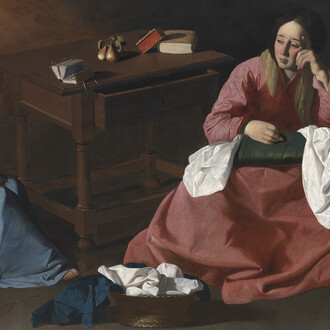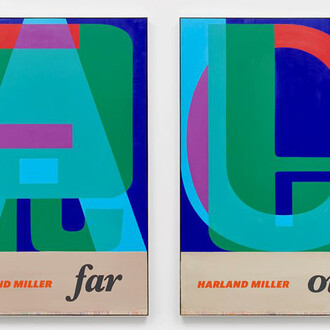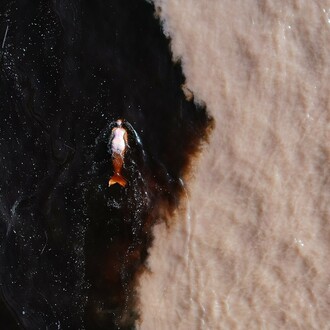JD Malat Gallery is honoured to present Atonal Drift, a new body of work by leading Turkish artist, Zümrütoğlu (b. 1970).
Atonal Drift brings together Zümrütoğlu’s highly expressive paintings and sculptures in an attempt to demonstrate how the artist explores the theme of the ‘dissonant and disharmonious body’ as well as the possibilities of figurative abstraction across different mediums. The dynamism of colour and fleshy painterliness which first captivated Zümrütoğlu’s audience through his paintings is now offered to the viewer through his new sculptural work. After a visceral shock, or being hit ‘in the gut’ as Zümrütoğlu often states, one begins to see figures slowly emerge and materialise through the thick paint and ceramic forms.
The title of the exhibition, Atonal Drift, marks an extension of the progressive thinking first expressed by Austrian-born composer and painter, Arnold Schoenberg (1874-1951). The boundaries between the visual and the musical have been extensively explored; from the Pythagoreans to the Modernists, visionaries and thinkers throughout history have developed theories that have connected harmony in music with art. As the literary and art critic Walter Pater (1839 – 1894) boldly announced, ‘all art aspires towards the condition of music’. What does it mean, then, to frame Zümrütoğlu’s work within one of the most challenging musical genres, personified by Schoenberg?
‘Atonality’ has been understood as a conscious attempt to avoid harmony in music. Schoenberg used ambiguous chords and improbable harmonic inflections, to create unusual melodic lines, purposefully going against the grain of tonal hierarchies that characterized classical European music between the seventeenth and nineteenth centuries. Although Schoenberg did in fact detest the term, ‘atonality’ became widely understood as the embodiment of challenge, transgression and defiance. Taking on the broadest sense of the term - as deviation from traditional structures and integral frameworks of different practices - ‘atonal’ in Zümrütoğlu’s new body of work denotes his ability to challenge the conventions of figurative painting to express a dissonant human form, while ‘drift’ demonstrates his exciting shift from the canvas to sculpture.
Informed by Western literature, philosophy and music, Zümrütoğlu’s work to date has engaged with the darker side of human existence. Moved by the work of German poet Heinrich von Kleist (1777-1811) and French Surrealist playwright Antonin Artaud (1896-1948), Zümrütoğlu has embraced themes such as the fragility of human existence, psychological anxiety and pollutions of the mind. Zümrütoğlu’s bold expression of form and heavily impastoed canvases become a motif for this central theme of the chaotic. By drawing upon the theme of ‘dissonance’ in music, Zümrütoğlu unveils yet another layer to his contemplation of the human form, mind and chaos. The strong connections to music in Atonal Drift bring to mind the artist’s synesthesia. As a neurological condition that causes the brain to process information in the form of several senses at once, synesthesia presents Zümrütoğlu with the ability to take a sensory approach to painting and sculpting, often seeing colours when hearing different sounds. In this way, it is natural to imagine how Zümrütoğlu could have experienced swathes of red resonating with vibrant blue to JD Malat Gallery is honoured to present Atonal Drift, a new body of work by leading Turkish artist, Zümrütoğlu (b. 1970).
Atonal Drift brings together Zümrütoğlu’s highly expressive paintings and sculptures in an attempt to demonstrate how the artist explores the theme of the ‘dissonant and disharmonious body’ as well as the possibilities of figurative abstraction across different mediums. The dynamism of colour and fleshy painterliness which first captivated Zümrütoğlu’s audience through his paintings, is now offered to the viewer through his new sculptural work. After a visceral shock, or being hit ‘in the gut’ as Zümrütoğlu often states, one begins to see figures slowly emerge and materialise through the thick paint and ceramic forms.
The title of the exhibition, Atonal Drift, marks an extension of the progressive thinking first expressed by Austrian-born composer and painter, Arnold Schoenberg (1874-1951). The boundaries between the visual and the musical have been extensively explored; from the Pythagoreans to the Modernists, visionaries and thinkers throughout history have developed theories that have connected harmony in music with art. As the literary and art critic Walter Pater (1839 – 1894) boldly announced, ‘all art aspires towards the condition of music’. What does it mean, then, to frame Zümrütoğlu’s work within one of the most challenging musical genres, personified by Schoenberg?
‘Atonality’ has been understood as a conscious attempt to avoid harmony in music. Schoenberg used ambiguous chords and improbable harmonic inflections, to create unusual melodic lines, purposefully going against the grain of tonal hierarchies that characterized classical European music between the seventeenth and nineteenth centuries. Although Schoenberg did in fact detest the term, ‘atonality’ became widely understood as the embodiment of challenge, transgression and defiance. Taking on the broadest sense of the term - as deviation from traditional structures and integral frameworks of different practices - ‘atonal’ in Zümrütoğlu’s new body of work denotes his ability to challenge the conventions of figurative painting to express a dissonant human form, while ‘drift’ demonstrates his exciting shift from the canvas to sculpture.
Informed by Western literature, philosophy and music, Zümrütoğlu’s work to date has engaged with the darker side of human existence. Moved by the work of German poet Heinrich von Kleist (1777-1811) and French Surrealist playwright Antonin Artaud (1896-1948), Zümrütoğlu has embraced themes such as the fragility of human existence, psychological anxiety and pollutions of the mind. Zümrütoğlu’s bold expression of form and heavily impastoed canvases become a motif for this central theme of the chaotic. By drawing upon the theme of ‘dissonance’ in music, Zümrütoğlu unveils yet another layer to his contemplation of the human form, mind and chaos. The strong connections to music in Atonal Drift bring to mind the artist’s synesthesia. As a neurological condition that causes the brain to process information in the form of several senses at once, synesthesia presents Zümrütoğlu with the ability to take a sensory approach to painting and sculpting, often seeing colours when hearing different sounds. In this way, it is natural to imagine how Zümrütoğlu could have experienced swathes of red resonating with vibrant blue to produce dissonant visual ‘chords’. With swirling strokes of thickly applied paint and disfigured ceramic forms, Zümrütoğlu presents figures whose corporeal boundaries are pushed beyond their limits, marking an expression of Zümrütoğlu’s contemplation of the darkness of humanity and bringing to life what he calls ‘the disharmonious body’.
Contextualising Atonal Drift within the pathway paved by visionaries who challenged tradition alerts the viewer to the unguarded and innovative nature of Zümrütoğlu’s work. There are no boundaries or limits. The viewer is always left wondering, what will he do next? The unpredictability inherent to Zümrütoğlu’s exploration of the human condition, as well as his ability to challenge traditional schemes of figurative representation, emphasises why he has caught the eye of leading international collectors and why he will always continue to fascinate a global audience.
Encountering a bold and diverse entity of work in Atonal Drift will therefore alert a global audience not only to the baseness of human nature, but also humanity’s deep desire to search for harmony amongst chaos. Engaging the viewer through painting and sculpture, Atonal Drift is a dynamic celebration of the best and worst of humanity in every form and emotion.
















